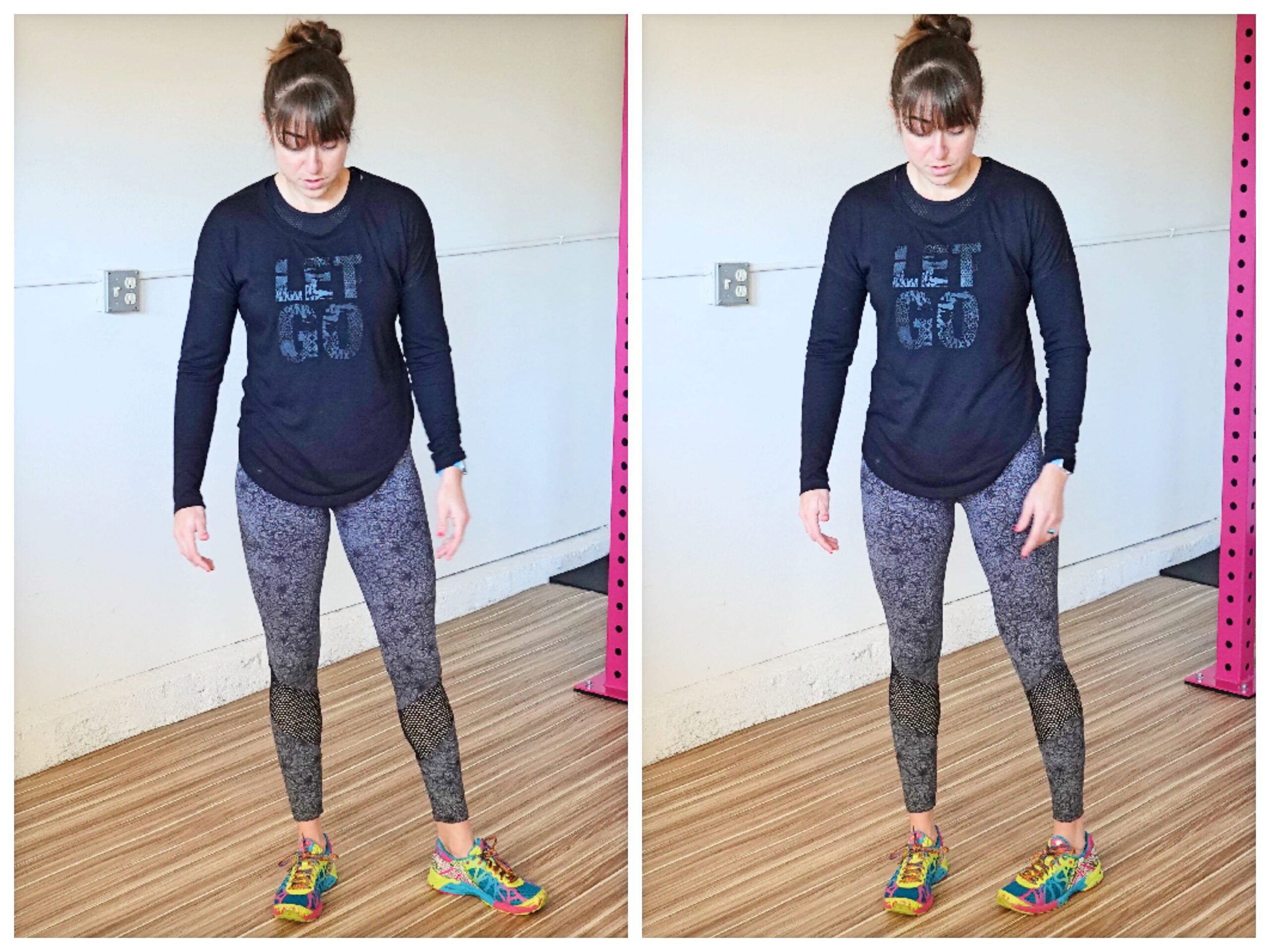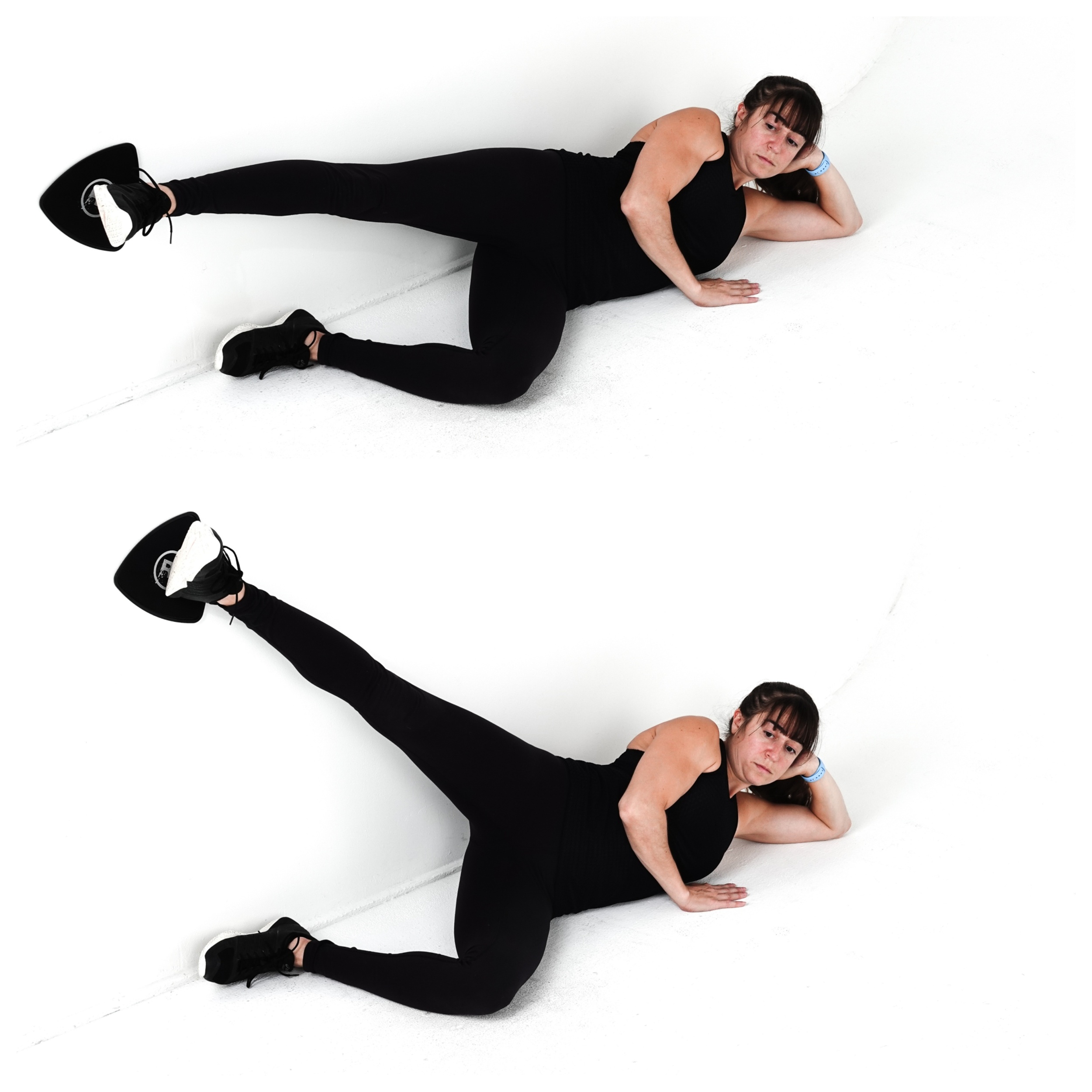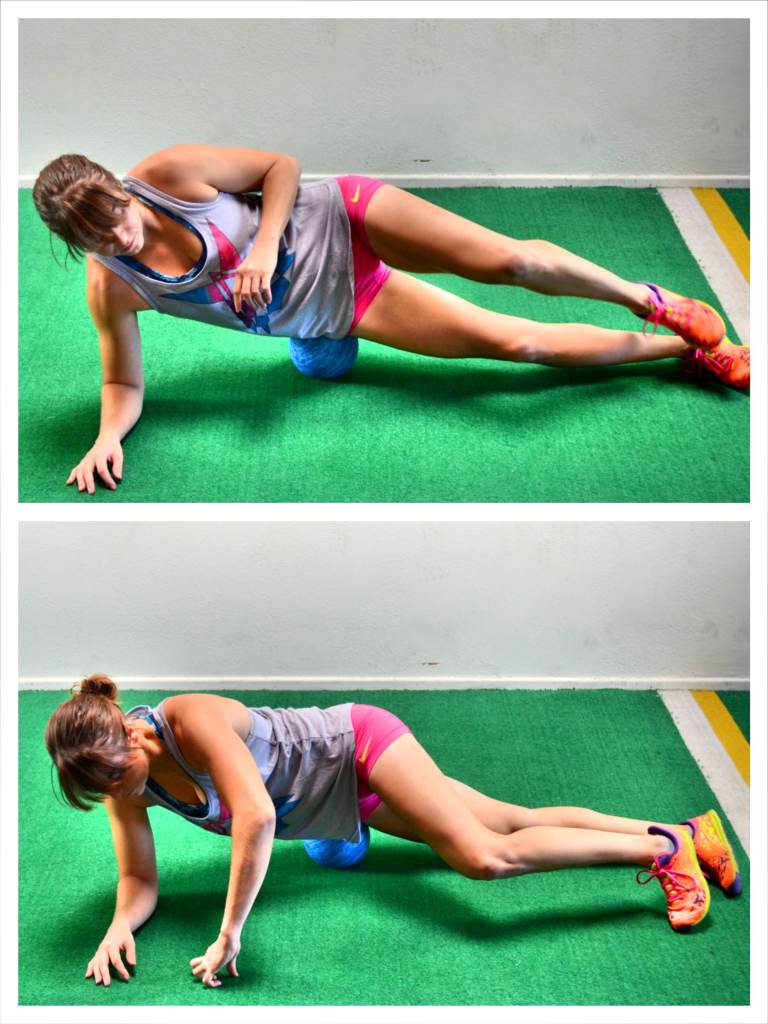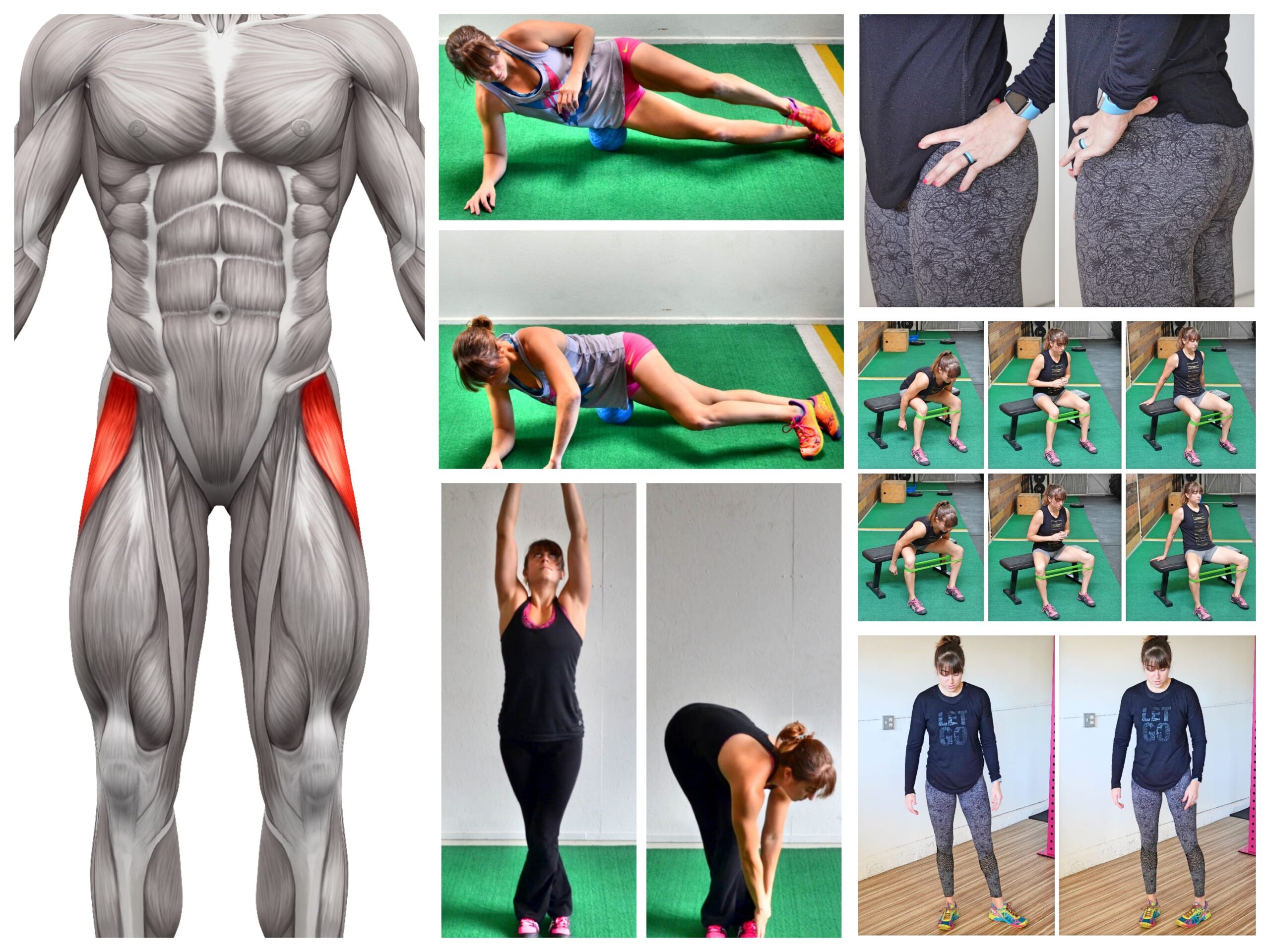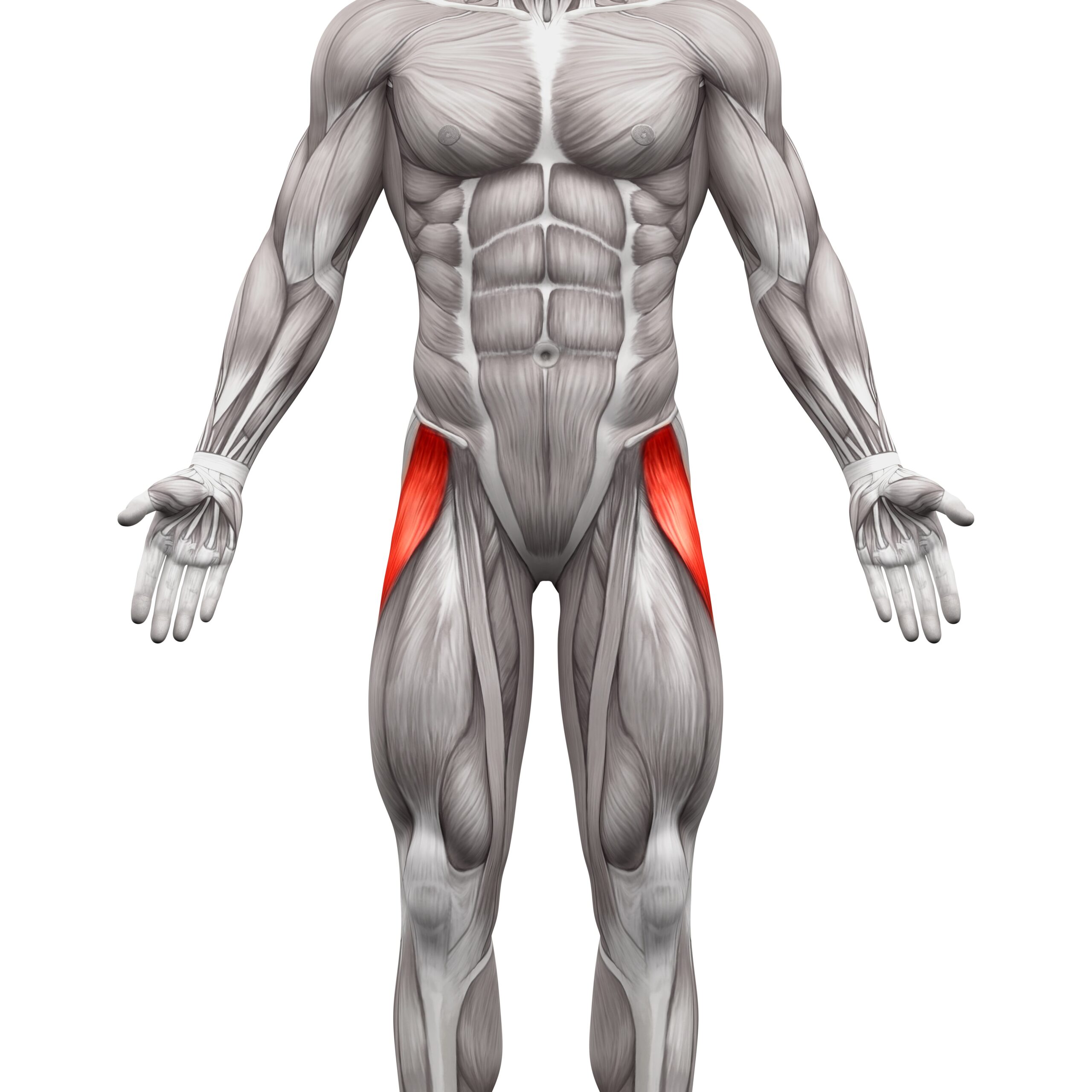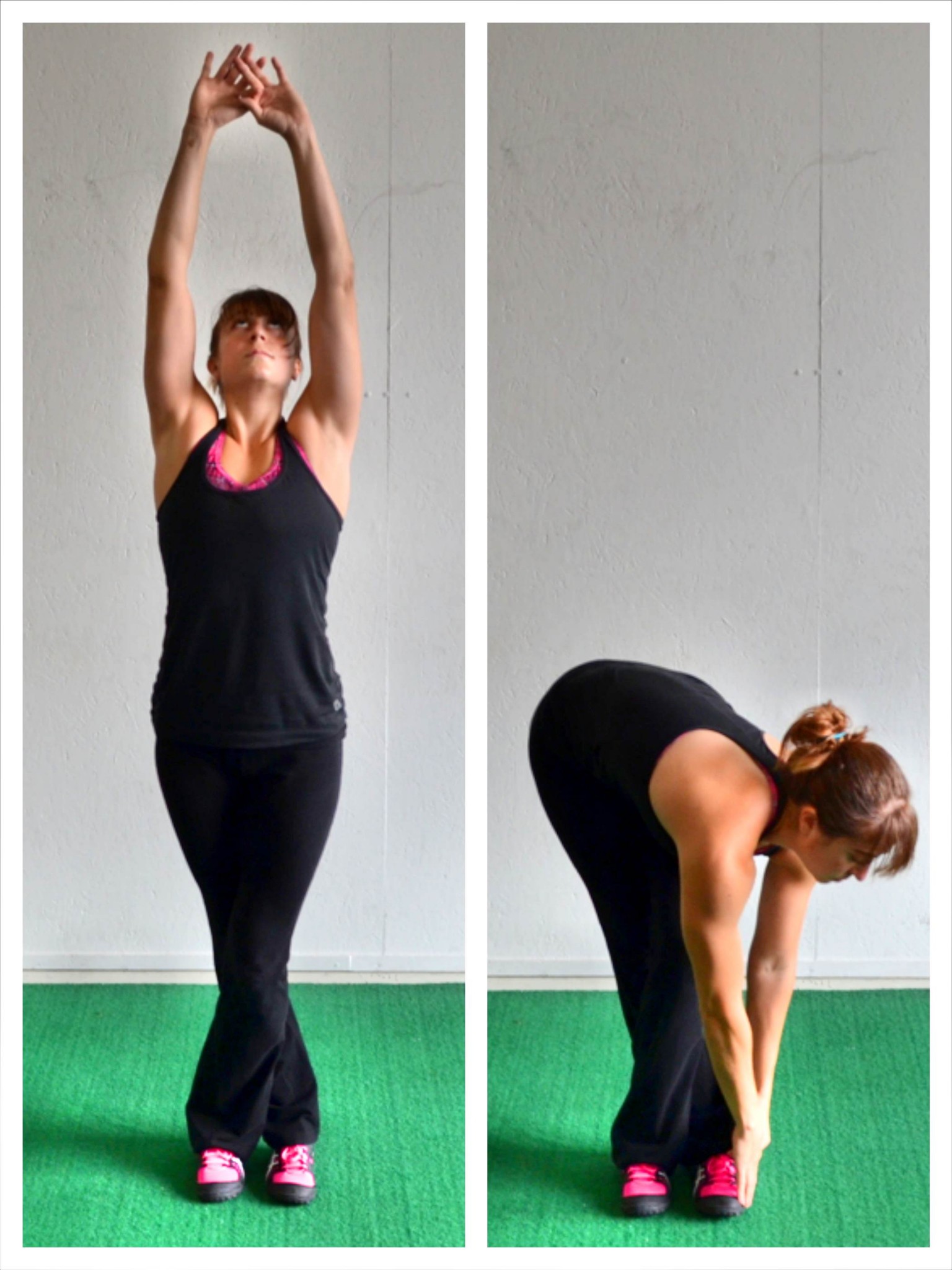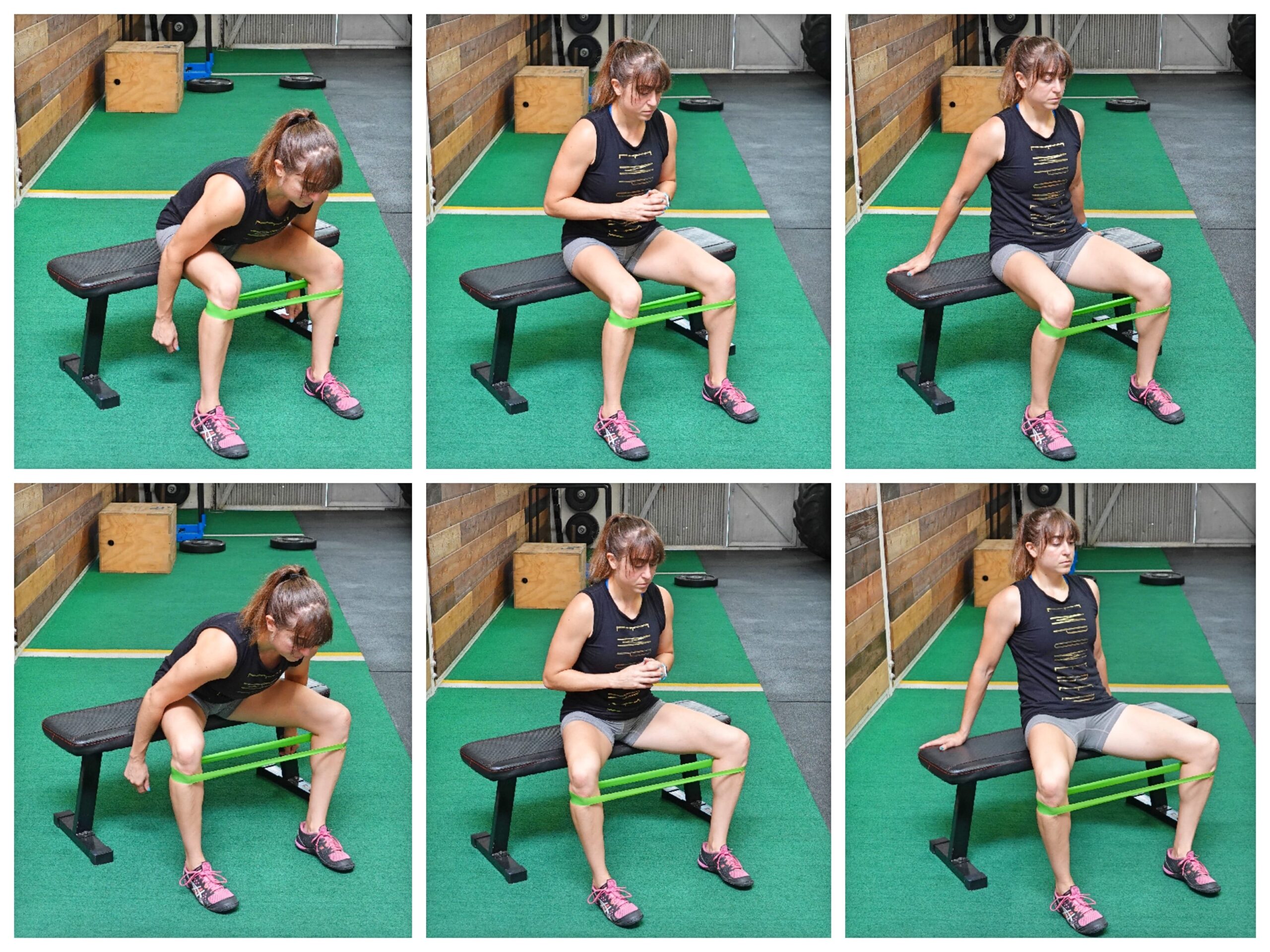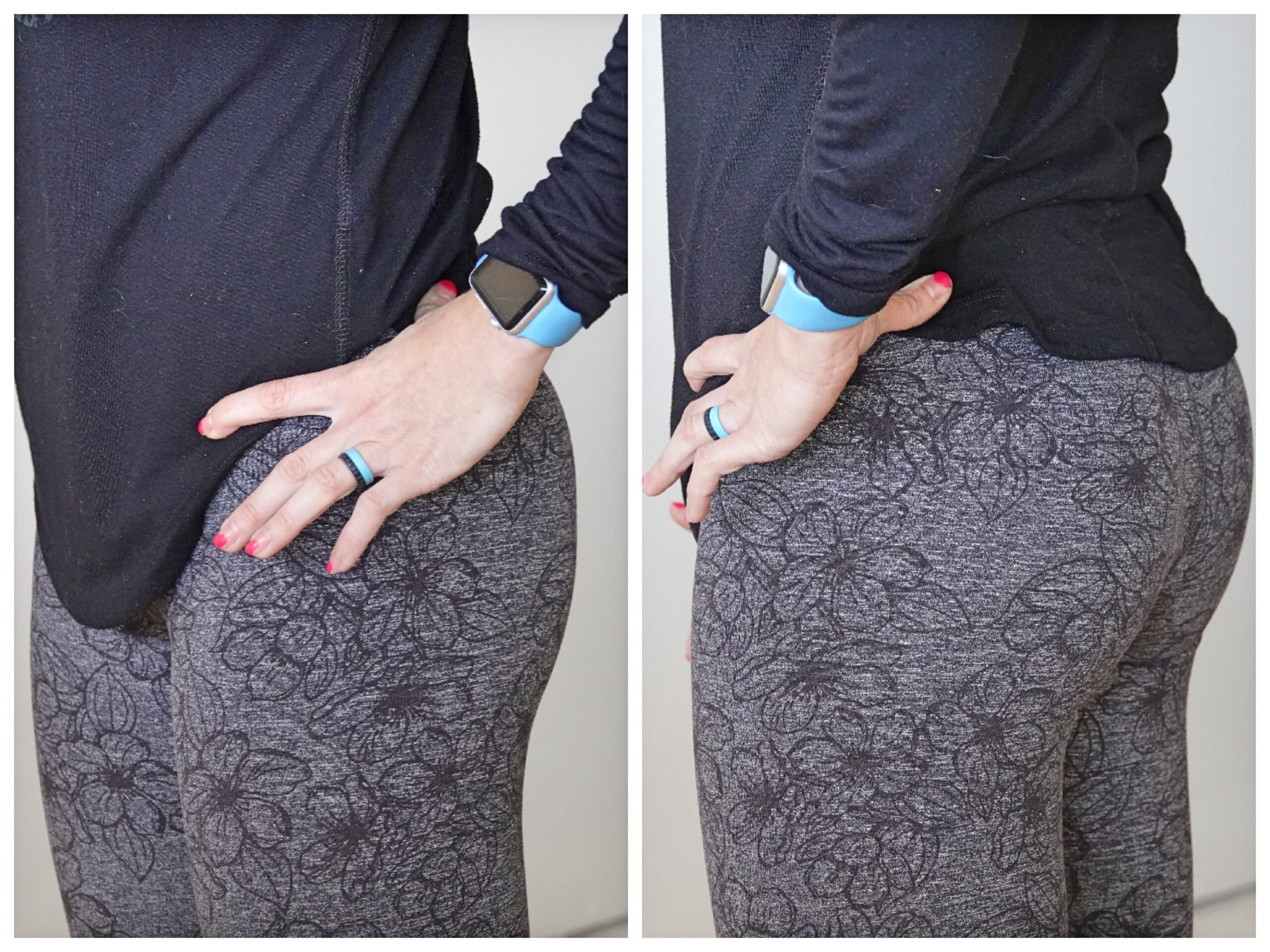
by Cori Lefkowith | Mar 24, 2020 | Blog, Butt, Exercises, Foam Rolling, Pain Relief
The psoas has become the sexy hip flexor muscle to talk about and work on.
But what if I told you that all too often the TRUE culprit of our back, hip, IT BAND, knee pain and even ANKLE pain had to do with ANOTHER hip flexor muscle?!
What if I told you that you should actually be paying attention to your TFL or your Tensor Fasciae Latae.

The TFL can be a nasty little sucker, compensating for a week glute medius, perpetuating IT Band tightness and impacting everything down to our feet and ankles.
It contributes to internal hip rotation AND external tibial rotation.
Because of its far reaching impact it is a muscle we can’t ignore.
However, the hard part about addressing TFL tightness and overactivity is that many of the moves we need to do to CORRECT the issue, can often PERPETUATE IT!
For instance, to help prevent the TFL from continuing to compensate, we need to include glute medius strengthening.
But ever notice how you’ll do Monster Walks and feel the front side of your hip working?
Ever push through thinking “Oh yea! Feel that burn!?”
Or maybe you don’t even think about what is working. You’re doing the “right moves” so you just believe you SHOULD get results, right?
WRONG!
If you’re doing the right moves but still allowing muscles to compensate, not only are you NOT correcting the problem, but you may be making it worse.
So when you feel that front outside of your hip working during those mini band walks? Guess what is not working as it should and what is also COMPENSATING for that underactive muscle!?
Well your glute medius is not getting the benefit of the exercise it should be getting and instead you’re perpetuating the overuse of your TFL!
So all of that rehab? It isn’t going to pay off.
While you need to strengthen your glute medius, you need to realize that all too often our TFL can compensate for a weak glute medius.
Because this muscle then becomes even further overworked and even shortened, it can lead to lower back hip and knee pain, not to mention even IT Band issues and foot and ankle problems!
Yup! Through our IT Band the TFL can create movement compensations down our entire leg!
And when we then see changes to our ANKLE mobility guess what happens? Those changes only further perpetuate those compensations back UP our kinetic chain.
It’s why you can’t just IGNORE aches and pains. The longer you ignore them and keep pushing through, the more you then just allow compensations and imbalances to build up so there is more to have to sort through later.
If you don’t address TFL issues, you’ll end up having to address issues from your feet up!
So how can we prevent our TFL from leading to all of these aches and pains when it wants to work during the exercises we NEED to be doing to correct it?
Here are three tips to help you quiet down that TFL and get your glutes activated! And to then implement these tips, check out the quick series I’ve included at the end of this post!
As you go through implementing these tips, be CONSCIOUS of what you feel working. Don’t just rush through the moves! Be intentional with your prehab moves!

3 Tips To Strengthen Your Glutes And Prevent Your TFL From Compensating!
#1: Treat the TFL like a toddler. Keep it distracted so you can get work done!
Basically, you want to adjust movements to help make it EASIER to establish that mind-body connection.
One way to do that is to “keep the TFL busy” by internally rotate your foot during lateral raise, or abduction, movements.
Because the TFL performs hip internal rotation, you can almost “distract” it with that movement AS you use the glute medius to perform the lateral raise.
So if during lateral raises you notice you often feel the front of your hip, turn your toe down toward the ground.
You may even notice often that your toe is turned out toward the ceiling.
The TFL contributes to tibial external rotation.
So internally rotate your foot is the OPPOSITE action, which can help “shut off” the TFL. Not to mention when you internally rotate your tibia, you often then even internally rotate our hip by extension.

Maintaining this internal rotation, you can then perform your lateral raise movement.
If you still are struggling to feel your glute medius, you can even kick slightly back as you raise up OR put your hip into extension, driving back into a slider or wall AS you perform that lateral raise movement.
This hip extension and slight kick back will engage your glute max, which will also hinder the TFL from taking over and allow you to potentially better activate your glute medius. This works because the TFL is a hip flexor so by putting your hip into extension, you can inhibit it from working!

#2: Change the hip flexion during those abduction moves.
When you’re first starting to “rehab” an issue, you need to use the moves you feel the most and build off of those.
Basically you want to take the path of least resistance to establish that mind-body connection.
If you feel a move working those glutes, use that first THEN even dive into other moves because you’ve already established that mind-body connection.
To find that move that helps you establish that mind-body connection, you may need to adjust the exact POSTURE you use during basic abduction moves.
By adjusting the amount of hip flexion or extension you perform the move in, you can find a way to maximize your glute medius engagement and minimize your TFL compensation.
It isn’t a clear cut and dry rule of what posture is best so you may want to play around to see what matches your personal recruitment patterns.
For some more flexion may “distract” the TFL because it is a hip flexor.
However, for some, more hip flexion may perpetuate it being overactive during those abduction moves.
In this case, putting the hip into more extension may be key to inhibit the muscle.
While you of course want the glute medius to be strong in both a slightly more hip-flexed or hip-extended state, you do want to start with the move you feel working correctly to make sure you establish that mind-body connection.
The fact that hip flexion can play a role in how much you’re able to engage the TFL is why that oh so “basic” clam exercise can so often backfire too!
The clam is a traditional glute activation movement. But this seemingly simple move is so often butchered. First off, you may find you need to use that internal rotation of the tibia I mentioned in the first tip to help.
Secondly, you may adjust how much you pull your knees forward or straighten your legs out.
The key is being conscious of what you feel working to then ADJUST your exact amount of hip flexion.
A great way to play around with different amount of hip flexion during even a bilateral abduction move is even seated on a bench.

You can lean back, sit up tall or even lean forward to different degrees to not only strengthen your glute medius in a variety of postures BUT also find the exact position that works best for you.
We have to remember to focus on what we feel working so we can work around our own biomechanics.
#3: Foam roll and stretch BEFORE you activate.
If you struggle to activate a muscle, you may find that foam rolling and stretching the muscle prior to doing activation moves is oh so key!
While people debate the benefit of both techniques, with one of the main arguments against them being that the benefits are short-lived, that doesn’t mean you can’t use these “short-lived” benefits to your advantage.
By rolling your TFL and then stretching to improve your hip mobility, you can inhibit this overactive muscle, even if just temporarily.

If you interrupt that mind-body connection between your TFL and brain, and restore muscles to their proper length-tension relationships, you can then help yourself better establish the mind-body connection to the muscle you DO want to work – your glute medius!
So if you find your TFL is being a pesky little sucker and compensating for your glute medius no matter what posture or tweaks you do, try relaxing and inhibiting it IMMEDIATELY PRIOR to doing the glute activation moves.
Interrupt that communication so you can establish a new connection to those glutes!
A lacrosse ball is a great way to relax that TFL and even a simple half kneeling hip stretch with reach can improve your hip extension.

BONUS: If you have an imbalance do imbalanced prehab!
The one other key thing to note is if you have an imbalance, you need to do imbalanced rehab.
So if one side is constantly tight, you need to address that one side specifically.
You also want to assess if it is glute weakness on that SAME side or if there is even weakness on the OTHER side perpetuating the issues and leading to the TFL becomign overworked!
Of course seeing someone to asses you is key but KNOWLEDGE IS POWER. So now you can be aware of what you’re doing in your workouts and therefore why you are, or aren’t, seeing the results you want to seek out the help you need.
Using these tweaks you can help yourself strengthen your glutes and prevent your TFL from constantly compensating!
Now try implementing them in this amazing series below!
Quick Hip Mobility Series To Prevent IT Band Issues, Back, Hip And Knee Pain!
This Avoid IT Band Issues Series uses foam rolling and stretching to address your TFL tightness and overactivity. It even works to relax your peroneal (the outside of your lower leg) to make sure you’re working on any issues from the ground up.
It then uses two great abduction moves to activate your glute medius!
The Avoid IT Band Issues Series
Complete 1 round through the circuit below, spending a minute per move on each side.
CIRCUIT:
1 minute per side Peroneal Foam Rolling
1 minute per side TFL Foam Rolling
1 minute Standing TFL Stretch
1 minute per side Lying QL Stretch
1 minute Bridge Abductions
1 minute per side Lying Side Raises
Need more amazing series to improve your hip mobility and prevent lower back, hip and knee pain?
Join my 28-Day Booty Burner program!

by Cori Lefkowith | Jan 23, 2019 | Blog, Butt, Core, Exercises, featured, Pain Relief
This one muscle causes more issues than we often realize. But because the pain and issues it often causes are “elsewhere,” we often don’t realize this nasty little culprit…
Ok…while no muscle is really “nasty” or “evil,” it is important we recognize the different roles specific muscles play in creating imbalances, compensations and injuries up and down our bodies.
And one muscle we need to pay more attention to is the TFL!
Too often we ignore the issues that can arise from a shortened or tight and overactive TFL or Tensor Fasciae Latae.
This muscle loves to try to take over for other muscles, especially our glute medius. And while often our IT Band, or sometimes even our hip flexors, get blamed, the TFL is ACTUALLY responsible for a variety of low back, hip and knee aches and pains!

The TFL – A Culprit Of IT Band, Low Back, Hip And Knee Pain!?

If you’ve ever had IT Band “issues” or IT Band Syndrome, you may want to take a closer look at your TFL.
A tight, overactive TFL can lead to increased tension on the IT Band, making it feel “tight,” and also cause irritation of the tissue between the IT Band and lateral aspect of the knee joint.
This can lead to knee aches and pains such as patellofemoral pain syndrome (this can also be called runner’s knee or jumper’s knee).
Tightness of the TFL can also restrict hip mobility and contribute to excessive anterior pelvic tilt. Both of these things can lead to hip and low back aches and pains.
And even though there is no direct connection between our TFL and ankle, guess what!?
Everything is connected!
A tight, overactive TFL has even been implicated in causing changes to ankle mobility because of how it also affects the knee joint.
Basically, if your TFL becomes tight and overactive, and you don’t address the imbalances it creates, potentially even because you are wasting time addressing “symptoms” of the problem (aka just focusing only on the point of pain), you can end up with compensations, immobility and imbalances that lead to aches, pains and INJURIES up and down your body!
What Does The TFL Or Tensor Fasciae Latae Do?
While you may be thinking, “Ok I get it. The TFL is a nasty little sucker and I need to relax and lengthen it, especially if I have any of those issues. Now just tell me how to do that!”
And I will provide you with moves below to help you do just that.
HOWEVER, it is important we understand the basic functions of this muscle so we can then be aware of when it may try to compensate during exercises and where we should be feeling the moves instead!
So what does the TFL do?
The TFL contributes to hip abduction (lifting your leg out to the side), hip flexion (bringing your knee up toward your chest) and hip internal rotation (rotating your hip to turn your toe and knee in toward your other leg).
At the knee it also contributes to tibial external rotation, which is when you turn your foot out.
And at your pelvis it assists in anteriorly tilting you pelvis, which, if the muscle is tight, can lead to excessive arching of your lower back.
Why is it important you understand these functions?
Because when you see the movements that the TFL performs, you can also start to see the muscles that may become weak and inhibited (or underactive) because your TFL is tight!
The most common muscle we need to activate, if our TFL is tight, is our GLUTES, especially our glute medius!
The glute medius is supposed to be our primary hip abductor. HOWEVER, if the TFL becomes shortened and overactive, it may restrict our glute medius from firing effectively and efficiently and even try to carry more of the load than it should.
Have you ever done Mini Band Monster Walks or Lateral Raises and really felt your hips burning?
That may be because the TFL is trying to take over for your glute medius instead of allowing it to work as it should!
So how do you avoid letting the TFL take over?

3 Moves To Help Relax The TFL And Activate Your Glute Medius:
The first step is relaxing that overactive muscle. But once you’ve relaxed that muscle, you must then make sure that you improve your mind-body connection to properly RECRUIT your glute medius to do the work it should.
That is why you need to FOAM ROLL + STRETCH + ACTIVATE!
Below is a foam rolling and stretching move for your TFL as well as an activation abduction move to strengthen your glute medius.
TFL Foam Rolling:
Relax this overactive muscle using this foam rolling move. Relaxing trigger points here may help you find relief too for a tight IT Band. Any time we hear “foam roll your IT Band” we should either focus on our lateral quad or our TFL.

To roll out your TFL, you can use a roller although a ball works best. The smaller and harder the ball, the more it will dig in. If there is too much pressure and you can’t relax while holding on the tight spot, use something softer or a roller without spikes.
Place a ball on the ground then position your body so the ball is just below and outside, or back, from your hip bone. Roll the ball around slowly to find a tight spot and then hold on any tight spots.
If you find a tight spot, hold on that spot and lift and lower your leg up and down. By lifting and lower the leg, you are flexing and relaxing the muscle, which will help loosen everything up as you hold.
As you seek out tight spots in your hip, bring the ball around front and right to the side under your hip bone. Again hold on any tight spots and even flex and relax your leg to help dig in.
You can work your way back out to the side of your hip, and even into your glutes as well, if you find any sore or tight spots. Remember you are holding and breathing to release not rolling fast back and forth over the spot.
TFL/IT Band Stretch:
I first learned this stretch when it was called the IT Band stretch, but the focus should actually be on your TFL. You may feel it all the way down the outside of that one leg even.

To do the Standing TFL or IT Band Stretch, start standing with your feet together. Then cross your left leg over your right leg. Bring the left foot over and back across until the big toe is even with the big toe of the right foot. You want your feet even so that your front leg (the left leg) is pressing the back leg (right leg) straight during the stretch.
If you struggle to balance or it is too much pressure on your knees to have your legs so tightly crossed, place the front foot a bit out in front, but make sure that you don’t bend that back knee as you hinge over to stretch.
Then reach your arms up overhead for a nice big stretch. After reaching up, hang over, reaching your arms down toward the instep of the back foot (right foot). Push your hips out to the right as you reach toward your right foot so you feel a stretch down the outside of that right hip and side. You may even feel it down your right hamstring and calf.
Hold for a breath or two. Then reach back up overhead and cross your legs the other way so your left foot is back. Again reach up overhead then reach down toward your left instep, pushing your hips out to the left. Keep alternating sides with a reach up overhead in between every time.
Try to touch the ground as you reach down while making sure to keep your legs straight.
If you really struggle to balance, you may need to stand with your feet together and not crossed over as you reach toward the outside of each foot while pushing your hips away.
The key is really pushing that hip out to the side. You can even change things up reaching overhead and even slightly back with the arm on the same side as the hip you are pushing out to the side.
3-Way Seated Abduction:
To target both the anterior and posterior fibers of the glute medius and make sure it is strong and activated from a variety of different angles, the 3-Way Seated Abductions is a great move to use before your workout. In our workouts, and even daily life, we need our glute medius to fire effectively with our body in a variety of positions, it is important we also do work to activate it with different degrees of hip flexion!
Also, if you feel your TFL only taking over during one position, you can make note of that positioning and even roll right prior to that version. You can even use the other two first to make sure your glute medius is fully firing before you get to that variation.
And while your TFL assists with hip flexion, sitting with your hips flexed where your TFL isn’t necessarily trying to flex more (aka relaxed because the bench is supporting you), say unlike standing where you may try to bend at the hips, may even help you prevent your TFL from taking over!

To do 3-Way Seated Mini Band Abductions, place the mini band right below your knees and sit on a bench. Start by sitting toward the front of the bench so you can lean back and put your hands on the bench behind you. Place your feet about hip-width apart.
Then press your knees open against the band as you lean back. Your feet may rock open but focus on using your glutes to press the band open with your knees. Do not let your knees cave in as you come back to the starting position. Complete all reps then move to sit up nice and tall.
Sitting nice and tall repeat, pressing out with your knees so you feel your glutes working. After completing all reps, lean forward and repeat the movement. You can hold on the bench outside your legs to lean forward or just lean over even lightly resting your arms on your legs.
Complete all reps in each of the 3 positions. Make sure you’re really focused on pressing your knees out to feel your glutes while controlling the band back in. To reduce tension, you can start with a lighter band or put your feet slightly closer together, but make sure there is tension on the band even in that starting position.
Don’t Just Go Through The Motions – Form Tweaks That Help Activate Your Glutes:
Now that you know this nasty little sucker is out there causing issues, and even have some good ideas of how to start dealing with those aches and pains, I do want to remind you that doing the “RIGHT” moves isn’t enough if you don’t feel the CORRECT MUSCLES WORKING!
That is part of the problem!
We do these abduction moves and our TFL tries to take over. Heck…it doesn’t try…we LET IT!
So doing more abduction moves for your glute medius can backfire if you aren’t feeling the right areas working. And simply having the move “look right” and performing a proper movement pattern, doesn’t mean you have a proper recruitment pattern.
As you do these moves, or any moves for that matter, make sure you FEEL THE RIGHT MUSCLES WORKING!
You want to use activation moves where your focus isn’t on lifting more to establish that mind-body connection so when you go lift heavy or run, those proper recruitment patterns are AUTOMATIC!
Assess where you feel working and tweak or change moves until you know that your glute medius is actually firing and your TFL isn’t just taking over.
Add in an extra round of foam rolling during your workout if you start to feel your TFL working. Reduce the loads or resistance you are using if you’re fatigued and compensating.
Or make small tweaks to even those activation moves to help prevent your TFL from taking over!
So what are some tweaks you can make? And how can you help yourself know that your glute medius is firing?
First, to help yourself focus on using your glute medius during abduction moves….
You need to know where you should be feeling it, right?
Place your pointer finger on your hip bone and your thumb back along the top side of your butt.
Where your thumb is?
Well that is where you want to feel those moves! Focus on feeling under your thumb working to start!

Now in terms of tweaking moves?
While your TFL assists with hip internal rotation, it also assists in external tibial rotation.
Often when people say they feel their hips during Monster Walks or lateral raises, you’ll notice their toes/feet start to rotate out.
By instead INTERNALLY rotating their foot, or turning their foot down and in, while the TFL does engage to internally rotate the hip, it sort of “keeps the TFL busy” during the lateral raises or abduction moves so the glute medius can act as the prime mover for those movements.

(In the picture above, the left shows external rotation vs. internal rotation on the right. You would want to set up like on the right and maintain that position through the lateral raise. It doesn’t have to be extreme internal rotation, just think slightly lead with your heel).
You can also often help engage that glute medius better by kicking slightly BACKWARD as you lift to the side. This prevents the TFL from flexing the hip and instead puts the hip in extension.
(Notice in the left picture I lift straight out to the side versus the right where I kick slightly backward as I raise out to the side. And SIDE NOTE: Especially if you are doing these for reps or adding a mini band, place your hands on a wall or something in front of you to balance. It also helps prevent you from rocking and engaging your lower back!)

Form, while important, isn’t this one solid thing we make it out to be! Try different body positions and tweaks to moves so YOU can establish that mind-body connection. Then start using variations from there as you gain more and more control!
Ready to prevent and alleviate lower back, hip and knee aches and pains?
Heard all too often you need to strengthen your core, especially your glutes?
Want to run faster, lift more, cycle further….and maybe even just build a strong, sexy lower body and butt?
–> Join my Glute Camp! <–


